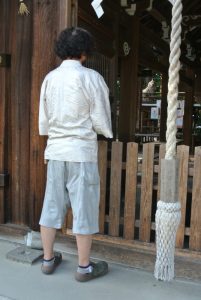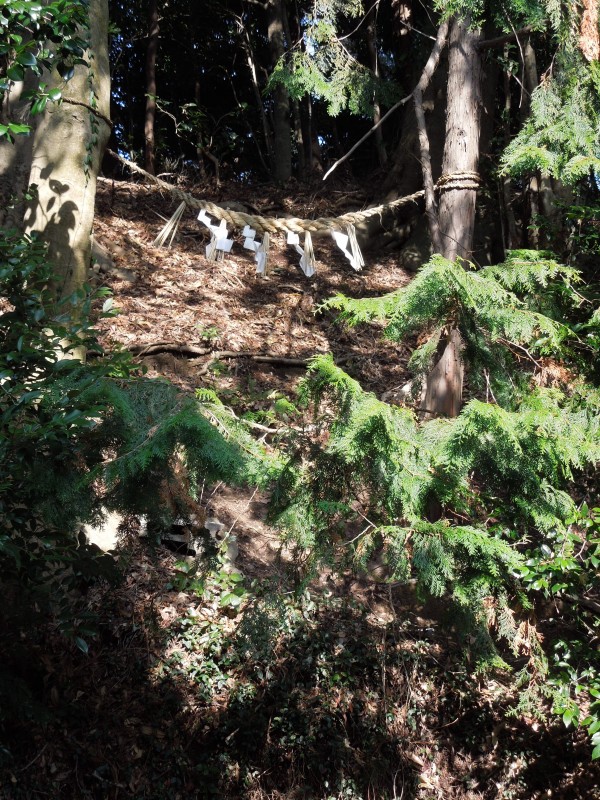
Izumo Taisha – for Hearn ‘the living centre of Shinto’
Christmas day in Japan, falling on a Sunday this year, seems an opportune time to consider the relative lack of Christianity in the country. This is despite some 150 years of Westernisation, yet only 1.5% of the population are Christian, amongst the lowest percentages in the world.
In my book on Hidden Christians I came to the conclusion that the incompatibility of Christianity with Japanese values was due to the hold of Shinto on the Japanese mind. I didn’t realise it at the time, but Lafcadio Hearn had made more or less the same point a hundred years earlier. It’s just one example amongst many of his renarkable perspicacity.
Following Hearn’s visit to Izumo Taisha, which greatly impressed him, he turned in his essay on the subject to speculation about the nature of Shinto and its hold on the Japanese mentality. In so doing he identifies the ‘mudswamp’ into which missionaries stumbled, as Endo Shusaku so graphically described in his writings (from Jan. 21, Martin Scorsese’s adaptation of Silence is going to hit Japanese screens.)
The following is taken from Hearn’s essay on ‘Kitsuki: The Most Ancient Shrine of Japan’ in the first of his 15 Japanese books, Glimpses of Unfamiliar Japan (1894). (The paragraphing is mine.)
But to have seen Kitzuki [Izumo] as I saw it is also to have seen something much more than a single wonderful temple. To see Kitzuki is to see the living centre of Shinto, and to feel the life-pulse of the ancient faith, throbbing as mightily in this nineteenth century as ever in that unknown past whereof the Kojiki itself, though written in a tongue no longer spoken, is but a modern record. Buddhism, changing form or slowly decaying through the centuries, might seem doomed to pass away at last from this Japan to which it came only as an alien faith; but Shinto, unchanging and vitally unchanged, still remains all dominant in the land of its birth, and only seems to gain in power and dignity with time.
Buddhism has a voluminous theology, a profound philosophy, a literature vast as the sea. Shinto has no philosophy, no code of ethics, no metaphysics; and yet, by its very immateriality, it can resist the invasion of Occidental thought as no other Orient faith can. Shinto extends a welcome to Western science, but remains the irresistible opponent of Western religion; and the foreign zealots who would strive against it are astounded to find the power that foils their uttermost efforts indefinable as magnetism and invulnerable as air. Indeed the best of our scholars have never been able to tell us what Shinto is. To some it appears to be merely ancestor-worship combined with nature-worship; to others again, it seems to be no religion at all; to the missionary of the more ignorant class it is the worst form of heathenism.
Doubtless the difficulty of explaining Shinto has been due simply to the fact that the sinologists have sought for the source of it in books: in the Kojiki and Nihongi, which are its histories; in the Norito, which are its prayers; in the commentaries of Motowori and Hirata, who were its greatest scholars. But the reality of Shinto lives not in books, nor in rites, nor in commandments, but in the national heart, of which it is the highest emotional religious expression, immortal and forever young. Far underlying all the surface crop of quaint superstitions and artless myths and fantastic magic there thrills a mighty spiritual force, the whole soul of a race with all its impulses and powers and intuitions. He who would know what Shinto is must learn to know that mysterious soul in which the sense of beauty and the power of art and the fire of heroism and magnetism of loyalty and the emotion of faith have become inherent, immanent, unconscious, instinctive.



I wonder if Lafacardio would say quite the same in 2017 given Japan is now
highly modern/tecnological society?
A very interesting comment by him then.
graham
I believe he would, though he railed against the encroaching modernisation of his time. Nonetheless it’s clear that Shinto is extremely flexible, and Shinto priests ‘purifying’ space missiles or torii on the roof of hi-tech complexes have become standard images of how tradition and technology seamlessly blend in contemporary Japan.
Hearn’s assertion that Shinto has neither philosophy nor metaphysics nor ethics is belied by the voluminous writings in Shinto metaphysics, ethics, and philosophy which were written by believers in the past and continue to be written today, not least notably in this very blog. I’ll take their opinions over the opinions of Hearn, a Buddhist foreigner who stayed in Japan for fourteen years, any day. How you can quote this particular passage with any amount of approbation is a mystery.
Good day, Wulf… Thank you for the input. I think Hearn’s point, which is often made by other experts in the field, is that there are no official pronouncements, meaning that officially there is no agreed doctrine or dogma. As you correctly point out, there are voluminous writings by believers. However, that is hardly the same thing, is it? Writings by believers take all forms, some of which may have no credibility at all. It’s worth remembering too that Shinto has changed greatly over the centuries, so that what might have been valid at one time is no longer valid at all. In the light of all this, I think Hearn, as usual, made a good point – which is why he’s held in high esteem by Japanese (including Shinto followers) to this day.
Hey John,
Did you have the opportunity to watch Scorsese’s movie? I was wondering what would your take on it be.
Love to read your website (and books).
Take care.
Thank you for the input, especially such a positive one! As for Silence, yes, I did see it and found it a very impressive production, as one would expect from someone like Martin Scorsese. It certainly scores big in terms of production values and in presenting a well-crafted storyline, though I had a couple of reservations myself. For one thing I found it overlong, with too much repetition of torture scenes, which makes the film somewhat gruelling to sit through. For another, I didn’t like the way the language issue was handled, since how exactly foreign missionaries were able to communicate complex theological issues in a very alien tongue was for me one of the most fascinating aspects of the historic encounter. Finally I wasn’t sure that the film made sufficiently clear why exactly the missionaries were so adamant that torture and death were preferable to the temporary denial of Christ (while secretly believing in him). I did very much like the final image, however, which upheld in visual form Endo Shusaku’s implicit support for Hidden Christians.